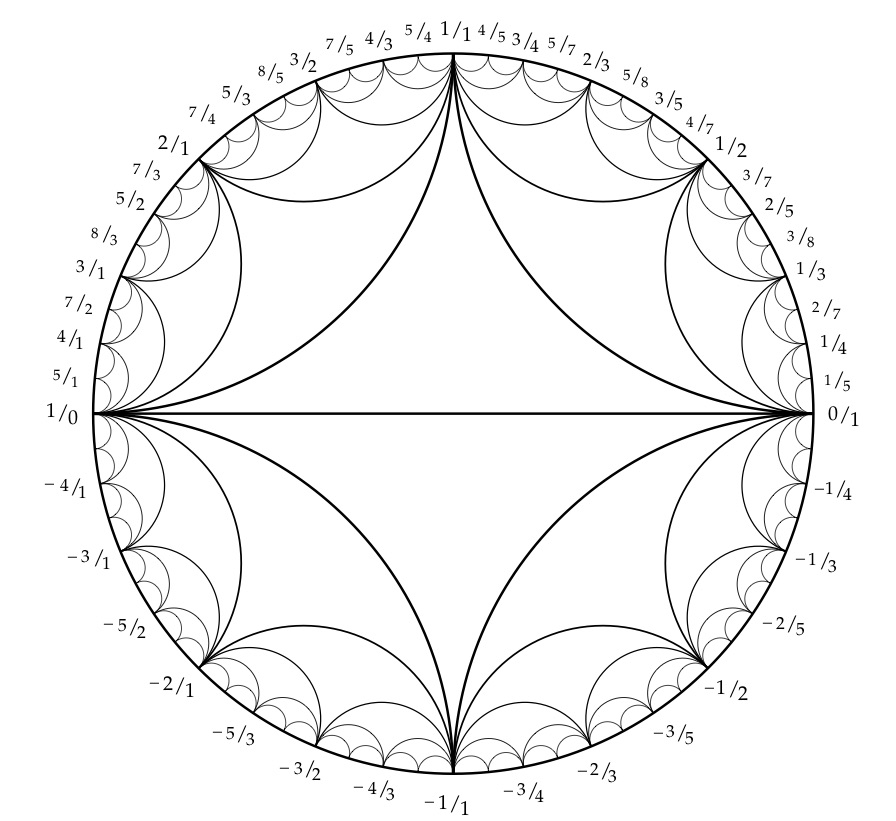Problem 0

Problem 1
Markoff numbers are integers that appear a Markoff triple
which are solutions of a Diophantine equation
the so-called Markoff cubic
Odd index Fibonacci numbers are Markoff numbers
Odd index Fibonacci numbers are sums of squares
Frobenius uniqueness conjecture
The largest integer in a triple determines the two other numbers.
- Only partial results
- m = Markoff number = z > y > x
- Jack Button for m prime
- Zhang An elementary proof...
- Lang, Tan A simple proof....
- Baragar m, 3m - 2, 3m + 2 prime
Problem 2:
Give a geometric proof of
If
References etc
- First proof Euler (reciprocity, descent)
- Heath-Brown, Fermat’s two squares theorem. Invariant (1984)
- Zagier, A one-sentence proof that every prime p = 1 (mod 4) is a sum of two squares, 1990
- Dolan, S., A very simple proof of the two-squares theorem, Math Gaz, 106(564). (2021) text
- Elsholtz, Combinatorial Approach to Sums of Two Squares and Related Problems. (2010)
Zagier: one sentence

Reciprocal arcs
- modular torus = quotient of
- pair of ideal triangles glued up
- elliptic involution swaps triangles fixes midpoint of diagonal arc
- swaps opposite edges and leaves diagonals invariant
- Def reciprocal arc = arc invariant by ell. inv.
and this
Problem 3:
Martin Aigner
- Proofs from THE BOOK
- 100 years of uniqueness
- Convexity and Aigner's Conjectures
There is a natural map (we'll see why shortly)
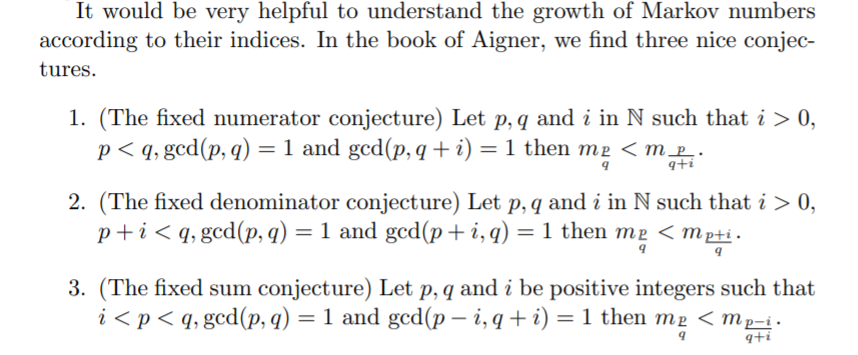
Aigner's monotonicity conjectures
- M. Rabideaua, R. Schiffler, Continued fractions and orderings on the Markov numbers, Advances in Mathematics Vol 370, 2020. arxiv 1801.07155
- C Lagisquet and E. Pelantová and S. Tavenas and L. Vuillon, On the Markov numbers: fixed numerator, denominator, and sum conjectures. Advances in Applied Mathematics Volume 130, September 2021 arxiv 2010.10335
- Kyungyong Lee, Li Li, Michelle Rabideau, Ralf Schiffler, On the ordering of the Markov numbers arxiv 2010.13010
Aigner's conjectures proof

Sketch of proof
Definition: Let
Natural map:
Theorem The shortest representative for a non trivial homology class is always a multiple of a closed simple geodesic.
- important
Aigner's conjectures proof

Labeling Markoff numbers
- Markoff number =
- Farey "tree" of coprime integers
- Markoff tree of solutions to the cubic
- Bass-Serre tree of a free product
- Mapping class group of the torus
Tree structure for triples
comes from Bass-Serre tree of
arcs
Farey diagram
- obvious transitive
Definition
arc = Poincaré geodesic joining
or
Ptolemy identity
Ptolemy identity is homogeneous
- (Ptolemy)
- ie a choice of horoballs based at the parabolic points
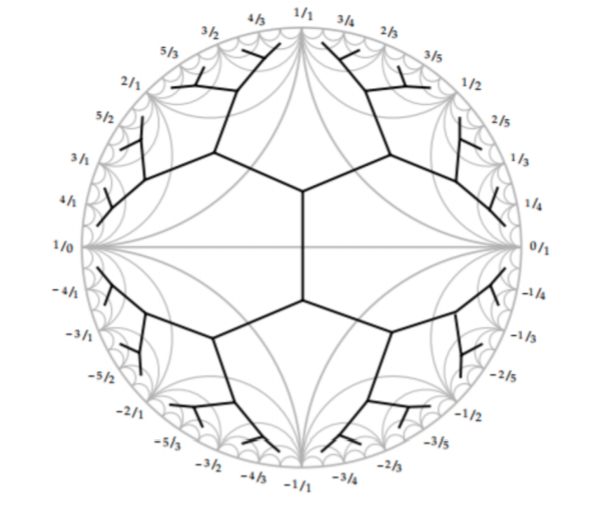
Tree structure
comes from Bass-Serre tree of
Role of the character variety
H. Cohn Approach to Markoff’s Minimal Forms Through Modular Functions (1955)
- modular torus = quotient of upper half plane
- relates Markoff numbers to lengths of simple closed geodesics
- modular torus = quotient of upper half plane
- length geodesic
- after normalising
Character variety
modular torus =
-
-
representation
-
Definition character map
-
-
-
Theorem: (Cohn and many others) The semi-algebraic set:
-
identified with the Teichmueller space of the punctured torus.
-
group of the automorphisms is induced by the action of the mapping class group
-
the permutation
-
the (Vieta) involution
-
- roots
- (trace)
- (Ptolemy)
Lemma A:
-
Proof:
-
(trace)
-
(Ptolemy)
- normalise so that
(Geometric) uniqueness conjecture
The multiplicity of any number in the complementary regions to the tree is at most 6.
Button's Theorem and
Button's Theorem
If
then there is a unique triple
Theorem (Fermat)
Let
- Button's theorem follows from "unicity" of
- unique factorisation
- The multiplicity of any number in the complementary regions to the tree is at most 6
Why 6?
- loop around the cusp
- automorphism group
- "generator" of the automorphism group is
- := elliptic involution has 3 fixed points which lift to the
- elliptic involution swaps triangles fixes midpoint of diagonal
- the fixed points lift to the
Ford circles
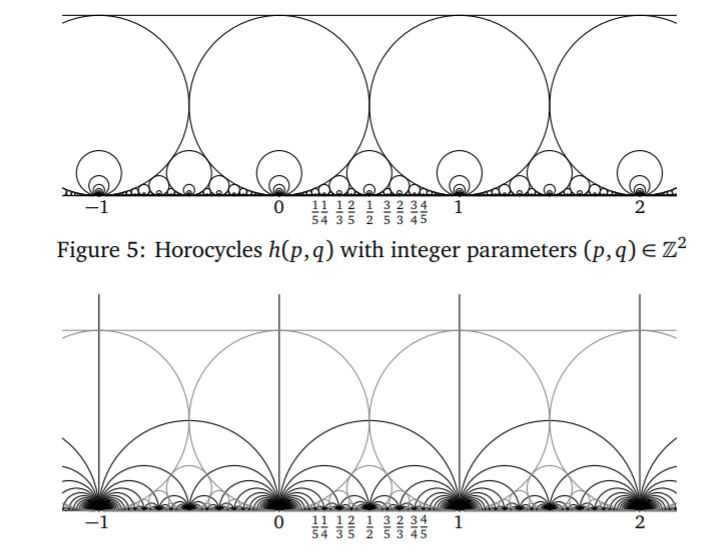
Proposition (Penner)
- arc joining
Corollary
If one of the Ford circles is
the midpoint of the arc is at Euclidean height
Corollary
One of the Ford circles is
the midpoint of the arc is at Euclidean height
blue arc
Lemma A'
Normalisation, fundamental triple
Corollary B
Every Markoff number
Geometric proof of Corollary B
- simple close geodesic
- the unique arc
- since
and so we have the equation
by the same argument....
Lemma C Let
The "number of ways" of writing
is equal to the number of arcs satisfying:
joins
integers
arc meets the orbit
Counting solutions
The "number of ways" of writing
- four choices for the signs
- swap
- Example:
-
Lemma C' Let
The "number of ways" of writing
is equal to the number of arcs
- on the modular surface
- of
- which pass through the cone point of of order 2.
Corollary B
Every Markoff number
Recursion for (complex) Markoff numbers
(Ptolemy)
In fact the Ptolemy relation factorises over
yields a recursion for a set of Gaussian integers
such that each Markoff number
- Example: Fibonacci numbers
Fibonacci numbers
x, y = 1 + 0J, 1 + 1J
fib = []
for k in range(10):
z = y*y.conjugate() + 1J
u = x*z/ (x*x.conjugate())
fib.append(f'{u}')
x, y = y, u
' '.join(fib)
- Just showing that
Back to Button exactly 6 simple arcs of
Proof of Button
every Markoff number
- if
Sums of squares
Button's Theorem
If
then there is a unique triple
Theorem F1: Let
has a solution over
if
Theorem F2: Let
has a solution over
iff
Theorem F3: Let
has a solution over
if
- arcs of
- immersed ideal triangles of
An immersed ideal triangles with sides of
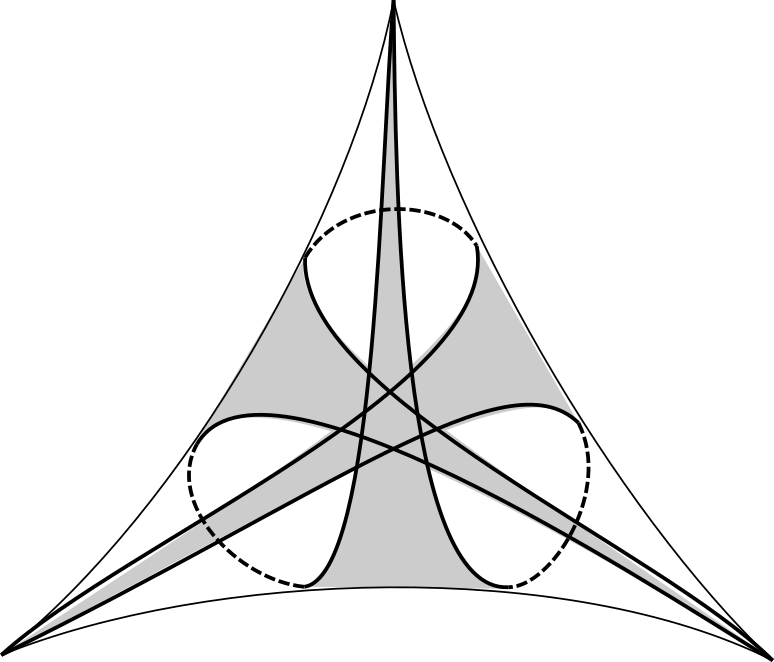
two groups of order 4
Acting on
Acting on
Zagier

Burnside Lemma
-
-
-
- proposition
If
then - Follows from Wilson's Theorem
"Geometric" proof: Group acting on
-
Count fixed points
-
identity
-
-
-
Apply Burnside
- if p=1 mod 4, then
Theorem F2: sum of 2 squares
Acting on
or on the arcs of
- standard fundamental domain
- = pair of ideal triangles
- all edges
of
- one dotted arc has
- other dotted arc has
Lemma C'
Let
The "number of ways" of writing
with
subgroup of automorphisms
fixing the cusp labeled
- a reflection
swaps
fixes the arc of - another reflection
fixes
fixes the arc of - both fix the midpoint
group lifts to
The set
- arcs joining cusps
- "lift to vertical lines" with endpoints
Fixed points I
First the automorphism
- fixes
- fixes the arc of
- swaps the upper and lower ideal triangles
The automorphism
fixes two and exactly two arcs in
Can then apply Burnside Lemma to prove Theorem F2
- Proof:
- suppose that there is an invariant arc that starts at
- then it must end at
- its
Questions/Remarks
Can other elementary results for quadratic forms?
-
using immersed "equilateral" ideal triangles. -
(Elsholtz)
using arcs -
Baragar ? m, 3m - 2, 3m + 2 prime
-
More detailed analysis of the spectrum of
Orthotree, orthoshapes and ortho-integral surfaces
Nhat Minh Doan

